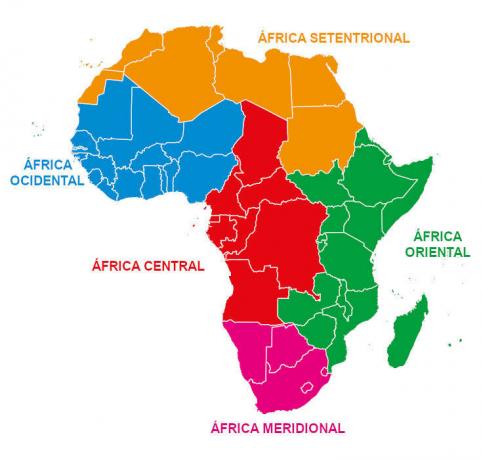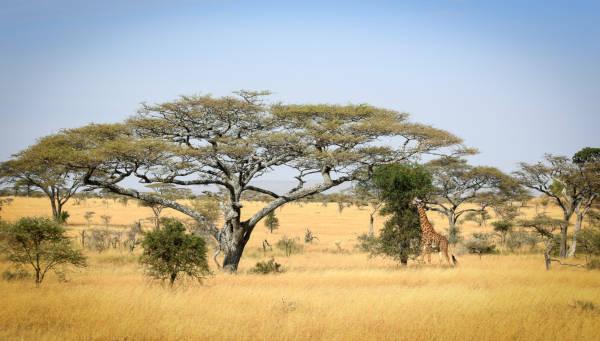Africa is one of the six continents of the world, being the third largest in territorial extension. The territory extends for more than 30 million km2, occupying, approximately, 20% of the continental area of the Earth. On the continent live more than a billion inhabitants, making it the second most populous among the rest.
Africa is known for its plurality ethnic and cultural, and through a millenary history, is able to tell the story of all mankind. Despite the continent's enormous wealth, many African countries have low development indices, with several social problems, such as poverty, low quality of life, malnutrition and illiteracy.
African countries are divided into two main regions — the North Africa and the Sub-Saharan Africa — and are also distributed in:
Central Africa
southern africa
North Africa
Western Africa
east africa
See too:Neocolonialism in Africa
all about africa
Continent |
Africa |
Gentile |
African |
Territorial extension |
30,221,532 km2 |
Population |
1,225,080,510 inhabitants |
Demographic density |
36.4 inhab/km2 |
Language |
In Africa, more than a thousand African languages are spoken, in addition to languages such as Arabic, English, French, Portuguese, Spanish, Africanêr, among others. |
countries |
54 countries and 7 independent territories |
biggest country |
Algeria |
Less country |
seychelles |
Africa Map

African countries and their capitals
Africa is made up of 54 countries, being 48 continental and 6 insular.
South Africa (Cape Town)
Angola (Luanda)
Algeria (Algiers)
Benin (Porto Novo)
Botswana (Gaborone)
Burkina Faso (Ouagadougou)
Burundi (Gitega)
Cameroon (Yaounde)
Chad (N'djamena)
Côte d'Ivoire (Abidjan)
Djibouti (Djibouti)
Egypt (Cairo)
Eritrea (Asmara)
Ethiopia (Addis Ababa)
Gabon (Libreville)
Gambia (Banjul)
Ghana (Accra)
guinea (Conakry)
Guinea Bissau (Bissau)
Equatorial Guinea (Malabo)
Madagascar Islands (Antananarivo)
Cape Verde Islands (City of Praia)
Comoros Island (Moroni)
São Tomé and Príncipe Islands (São Tomé)
Seychelles Islands (Victoria)
Lesotho (Maseru)
Liberia (Monrovia)
Libya (Tripoli)
Malawi (Lilongwe)
Mali (Bamako)
Morocco (Rabat)
Mauritania (Nouakchott)
Mozambique (Maputo)
Namibia (Windhoek)
Niger (Niamey)
Nigeria (Abuja)
Kenya (Nairobi)
Central African Republic (Bangui)
Democratic Republic of Congo (Kinshasa)
Congo Republic (Brazzaville)
Republic of Mauritius (Port Louis)
Rwanda (Kigali)
Senegal (Dakar)
Sierra Leone (Freetown)
Somalia (Mogadishu)
Swatini (Lobamba)
Sudan (Khartoum)
South Sudan (Juba)
Tanzania (Dodoma)
Togo (Lomé)
Tunisia (Tunis)
Uganda (Kampala)
Zambia (Lusaka)
Zimbabwe (Harare)
Read too:countries of america
Is Africa a country?
No, Africa is not a country but a continent. This question, while it seems obvious, implies a very common question among most people: refer to the African territory as homogeneous. And no, he isn't. Africa is one of the most diverse regions in the world, in cultural, religious, ethnic, political and geographical terms.
In Africa there is a country called South Africa. It accounts for about a fifth of the continent's economy.
Africa regions

Africa is divided into five major regions.
We know that the African continent has a great biodiversity, as well as extensive cultural, ethnic, religious and political diversity. Thus, to facilitate the analysis and observation of some areas, the continent was divided into five regions:
1) Central Africa
It covers the territories of the following countries: Central African Republic, Democratic Republic of Congo, Angola, Chad, Cameroon and Republic of Congo. This region is limited to the Atlantic Ocean, to the west, and mountainous regions, to the east. It is crossed by several rivers, has high temperatures, high air humidity, predominance of tropical weather and presence of savannas.
2)southern africa
It covers the territories of the following countries: South Africa, Botswana, Comoros, Lesotho, Malawi, Mozambique, Namibia, Swatini, Zambia and Zimbabwe. This region is characterized by the presence of plateaus; tropical weather, desert and Mediterranean; and vegetation of savannas, steppes and forests. Part of it is rich in minerals such as gold, copper and chromium. Elsewhere, the agriculture, such as sugarcane, coffee and tobacco plantations.
3) North Africa
It covers the territories of the following countries: Algeria, Egypt, Libya, Morocco, Sudan and Tunisia, being the largest region on the continent in terms of area. The population is distributed heterogeneously throughout the area, concentrating on the higher humidity portions.
In this region, also called North Africa, there is a large concentration of ores aimed at the export market, while agriculture is underdeveloped due to its conditions. natural. Only in the Valley of Nilo river is that agriculture develops, due to the great fertility of the soil, thanks to the floods of the river.
4) West Africa
Covers the territories of the following countries: Benin, Burkina, Faso, Cape Verde, Côte d'Ivoire, Gabon, Gambia, Ghana, Guinea, Guinea-Bissau, Equatorial Guinea, Liberia, Mali, Mauritania, Niger, Nigeria, Senegal, Sierra Leone, São Tomé and Príncipe, and Togo. It is located between the Saara's desert and the Gulf of Guinea.
West Africa is characterized by the predominance of climate equatorial, vegetation represented by savannas and forests. The population is especially concentrated in the southern regions, as the geographic conditions in the Sahara are not population attractions. In this area, agriculture is one of the economic activities practiced, with emphasis on the cultivation of sugar cane, cocoa and bananas.
5) East Africa
It covers the territories of the following countries: Burundi, Djinouti, Eritrea, Ethiopia, Kenya, Rwanda, Madagascar Islands, Seychelles, Somalia, Tanzania and Uganda. It is located between the Congo river basin region and the Indian Ocean.
East Africa is characterized by the presence of mountain formations, volcanoes and lakes. The predominant climate is tropical, and the vegetation is of the equatorial, savanna and steppe types, with desert areas.
The region's economy is based on agriculture with the cultivation of coffee and cotton, aimed at the market of export. This region has low levels of human development and several social problems.
history of africa
Africa is the cradle of humanity, as there are signs that the continent was the first to be inhabited by humans. In it were found several fossils that prove this theory and also made it possible to study the evolution human. It is estimated that the northern portion of the continent is the oldest in the world, in which the Egyptian peoples.
The continent was colonized by European peoples, such as the Spanish, Portuguese and French. Many Africans were uprooted and taken from their countries to other parts of the world by Europeans in order to carry out the slavery.
Thus Africa was divided during its colonization, according to the interests of the colonizers, who ignored the reality and identity of peoples, grouping them into tribes with cultural disparities. It was after the Second World War that the African colonies started their independence process. However, the continent still lives diverse territorial and religious conflicts.
Read too:slavery in africa
population and languages
More than a billion people live on the continent. However, despite the high contingent, Africa presents an unequal population distribution, due to the geographical conditions that disfavor the occupation of the areas.
The African continent coexists with big social problems. Many countries have low Human Development Indices. A large part of the population of some countries lives with a low quality of life, hunger and poverty. At birth and death rates are very tall, while life expectancy is low.
there is a big cultural diversity on the continent, which has various ethnicities, traditions, religions and languages. In addition to thousands of African languages, languages brought by the colonizers are spoken, such as French, English and Portuguese. The latter is spoken by five countries: Cape Verde, Guinea-Bissau, São Tomé and Príncipe, Mozambique and Angola. Recently Equatorial Guinea has also adopted the language. If you are curious about this topic, read our text: African population.
The African continent presents, in almost all of its territory, plateaus with approximately 750 meters of altitude limited by cliffs.
In the Sahara Desert region (northern region), is the northern plateau through which the Nile River flows. In the eastern region, there are large mountains such as Kilimanjaro and Mount Kenya. In the southern part, there is the Cape chain, with an altitude exceeding 3400 meters.
Climate
The African territory is quite diverse in climatic terms. We can find areas with a predominance of equatorial climate, other weather tropical, as there are also climate regions desert and mediterranean. The equatorial climate is recorded in the western region; the tropical, in the central and southern region; the desert, in the northern region, as well as the Mediterranean climate.
Vegetation

Savannah is the predominant vegetation on the African continent.
On the African continent, tracks of equatorial forest; savannas that predominate over most of the continent; vegetation mediterranean; and steppes. If you are more interested in the African climate and vegetation, read our text: Natural Aspects of Africa.
Economy
Economic and human development indices show that the African continent is the poorest among the continents. Many countries are consideredunderdeveloped.
THE African economy is based mainly on the primary sector, like extractivismand agriculture and livestock. The continent is rich in minerals such as gold and diamonds. In some countries are also found Petroleum and natural gas. The exploitation of natural resources is carried out by Europeans and also by North Americans, which impedes the country's development based on its own wealth.
See too:Slavery in mining activity
Animal and plant extraction also stands out. With regard to agriculture, agriculture carried out in some places is for subsistence and, in others, to end commercial.
The main subsistence crops are: cassava, maize, yam and sorghum. Among the crops aimed at the market, cotton, cocoa, coffee and peanuts stand out. In relation to livestock, cattle raising is highlighted in several areas. Sheep breeding is also common in the south of the continent.
Know more:what is underdevelopment?
Curiosities
Many tourists come to Africa to go on safari. The encounter with wild animals in the great African savannas is on the itinerary of many adventurers.
O Nilo river is considered the longest river in the world.
Of the 30 poorest countries in the world, 21 are African.
Angola and South Africa are the countries with the highest Gross Domestic Product from Africa.
The Sahara, the largest desert in the world, is located in Africa.
by Rafaela Sousa
Graduated in Geography
Source: Brazil School - https://brasilescola.uol.com.br/geografia/africa-continente.htm
